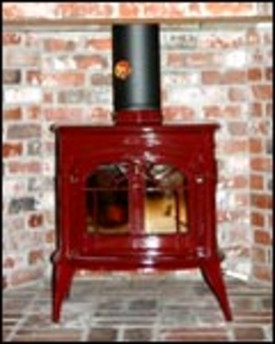 Have a certified stove installer check for sizing and clearance before you buy a stove. An 18-inch hearth clearance is necessary for safe installation of this woodburning stove.  The distance from the stove connection to the flue is measured in preparation for the stove pipe.  An elbow and collar are created and attached to the flue opening in preparation for the stove connection.  Once installed, your wood-burning stove and flue should be checked annually by a certified CSIA chimney sweep to prevent creosote buildup, deterioration, and foul odors. |
When installing a wood-burning stove, there are three key concerns to keep in mind: safety, warmth, and efficiency. Working with a qualified stove dealer is the first step in identifying the right stove for you. “You’re taking a furnace and you’re putting it in your living room,” says Doug Sherman, a retired fire fighter, certified Chimney Service Institiute of America (CSIA) installer, and owner of Top to Bottom Chimney Service, the Cape Cod firm who installed this Vermont Castings wood stove.
“I’m a firm believer that before you buy anything, have someone from a hearth shop come out to properly size it,” Sherman says. Having a stove in the wrong place, buying the wrong size, or buying a model that doesn’t suit the application could all spell disaster, so it’s best to confer with a trained consultant before you begin.
Stove Sizing and Venting
Safety issues center around stove clearance and flue sizing. A wood stove like this one from Vermont Castings requires an 18-inch clearance from wood or combustible materials. In most instances that means a hearth extension. In this case, the hearth was originally designed for a stove, so the clearance issue was easy to resolve. Sherman had intended to install a T-connector for easy cleaning where the flue meets the stove, but it would have compromised the 18-inch clearance. Since all installations require a six-inch pipe run through the flue, and most flues are 12-by-12 inch, installing a wood stove requires a chimney liner.
Sherman uses a flexible, stainless-steel liner to properly size the flue for drafting. He fishes it down through the top, through the damper and smoke box, and attaches it to a T-connector and into the stove. At the top, the liner has a ready-made storm collar and cap to protect the chimney from critters and moisture.
Proper Stove Clearance
Sherman reminds homeowners that they must also be aware of the stove-to-mantel clearance that is required when installing a stove or surrounding it by a hearth. The proper clearance prevents fire and must be accommodated. Sometimes that means mantle replacement, masonry, or hearth extensions. Again, a trained, certified installer can check to verify proper clearance.
Size is also an issue. Stoves are rated by the amount of heat they put out. If a stove is too large for its space, homeowners tend to shut them down when the room overheats. This results in improperly burning the wood, which creates a buildup of moisture and creosote in the flue. Creosote buildup can block the flue, preventing proper drafting. It can also eat away at liners since the creosote is acidic. Above all, using a stove in this way is counter to its intended use and reduces efficiency and proper burning.
High-Efficiency Stoves
Stoves today are high-efficiency, smart-burning stoves. “All the Vermont Castings products have a reburn system where flue gasses are channeled and reignite,” Sherman explains. Once the gasses reach a certain temperature, they reignite, which means it is a cleaner burning, more efficient stove. Especially for homeowners who tend to burn wood with a higher moisture content, this system prevents moisture and creosote buildup while taking advantage of the gasses to generate more heat, more efficiently.
No matter the efficiency of the unit, flues should be checked after each hard burning season. “Condensation and chimney odor are the real reason,” Sherman says. Any buildup of creosote can generate odors during the warm, moist summer months. It’s also easier and usually cheaper to have the chimney checked and cleaned in the spring, before buildup has had a chance to solidify or eat away at flue pipe. Sherman stresses that homeowners should have a CSIA certified sweep to check flues, stoves, and masonry. Safety is the primary concern for stove owners. It’s important to have sweeps and installers who are trained and certified.
Credit: Renovate Your World




























